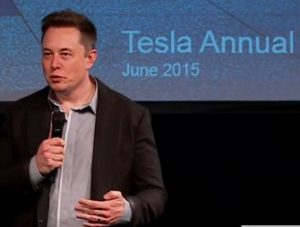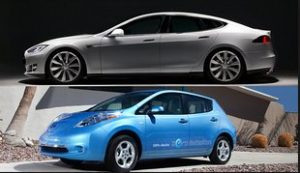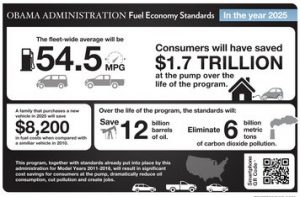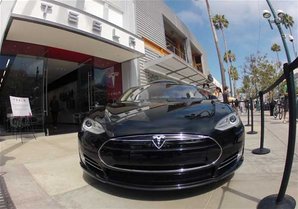by Jon LeSage, editor and publisher, Green Auto Market
Here’s my take on the 10 most significant and interesting occurrences during the past week…….
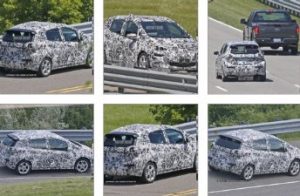 The Chevrolet Bolt electric vehicle, which grabbed eyeballs during its unveiling at the Detroit auto show as a concept car, was the subject of spy shots last week. A spy photographer took pictures of the Bolt on a test track in the Detroit area. The 200-mile range Bolt hatchback is expected to start production in late 2016 at General Motor’s Lake Orion assembly plant, for market launch in 2017. Shown off originally with its sunset-orange paint as a concept car, the spy shots show this test model has been painted in the camouflage style commonly seen on test tracks in recent years. The exterior paint makes it hard to see all the details, but there is one slight difference from the concept car – a black roof-mounted wing. There might also be some new lighting elements near the rear bumper. The price of the Chevrolet Bolt is expected to be around $30,000 after a $7,500 federal tax credit.
The Chevrolet Bolt electric vehicle, which grabbed eyeballs during its unveiling at the Detroit auto show as a concept car, was the subject of spy shots last week. A spy photographer took pictures of the Bolt on a test track in the Detroit area. The 200-mile range Bolt hatchback is expected to start production in late 2016 at General Motor’s Lake Orion assembly plant, for market launch in 2017. Shown off originally with its sunset-orange paint as a concept car, the spy shots show this test model has been painted in the camouflage style commonly seen on test tracks in recent years. The exterior paint makes it hard to see all the details, but there is one slight difference from the concept car – a black roof-mounted wing. There might also be some new lighting elements near the rear bumper. The price of the Chevrolet Bolt is expected to be around $30,000 after a $7,500 federal tax credit.- Rethink Methane Symposium took place for the first time last week in Sacramento. Presented by ACT Expo organizer Gladstein, Neandross & Associates, the symposium featured stakeholders in the natural gas, bioenergy, solar, wind, hydrogen, and fuel cell industries. Panel speakers explored how renewable methane from biological and synthetic sources can help California meet its climate protection and air quality improvement goals. Speakers included California Senator Fran Pavley, who co-authored California’s AB 32 and chairs the Select Committee on Climate Change and Assembly Bill 32 Implementation; California Senator Ben Allen, sponsor of a bill to establish a renewable gas standard for California’s gas utilities; and Peter Lehner, executive director of the Natural Resources Defense Council. One of the themes of the symposium was the importance of having policies and incentives in place to accelerate production of renewable methane from a variety of sources including organic waste, landfills, and wastewater treatment plants.
- Honda committed to hydrogen, leaving natural gas: Honda will be bringing its first production scale hydrogen fuel cell vehicle to market in 2016, while also stopping production of the Honda Civic Natural Gas. That alt-fuel car was introduced in 1998 and has only seen 16,000 units sold since then. John Mendel, head of US sales for American Honda, says that gasoline prices being down influenced that decision. Mendel also said that the Honda Accord plug-in hybrid will go out of production and will be replaced by another plug-in hybrid by 2018.
- More “new energy” cars coming to China: Guangzhou Automobile Group Motor will be investing about $322 million in a factory in China that will exclusively build green “new energy” vehicles; details on what technology will be used haven’t been given. The company, a subsidiary of Guangzhou Automobile Group, currently sells hybrid and range-extended electric versions of its GA5 sedan, with a hybrid version of its GS4 SUV scheduled to be launched next year. China’s “new energy” policy is aiming to clean up increasing air pollution in its cities, with green vehicles making for a big part of it.
- EcoCAR 3 year one winners named: Ohio State University has taken the top spot in Year One of the EcoCAR 3 competiton, according to co-sponsors, the US Dept. of Energy and General Motors Corp. Virginia Tech and the University of Waterloo took second and third place respectively in the first part of a four-year collegiate engineering programs where students have the opportunity to design, build, and demonstrate clean, advanced vehicle technologies. This time, all the teams are working on conversion projects built on the 2016 Chevrolet Camara.
- VIA Motors gains CARB and EPA certifications: VIA Motors announced that its plug-in hybrid Chevrolet Silverado has been given emissions certification by the California Air Resources Board (CARB) and by the US Environmental Protection Agency (EPA). The plug-in Silverado pickup truck has a 40-mile battery range and averages 100 mpg in typical daily driving, VIA says. Having a big fuel tank (16 gallons) allows it go an additional 400 miles of gasoline and electric miles.
- Nissan sponsoring National Drive Electric Week: Nissan just made an agreement to be the national sponsor of the annual National Drive Electric Week for the next three years. The Nissan Leaf continues to be the highest selling electric vehicle ever, now closing in on 200,000 global sales since its introduction in December 2010. This year’s National Drive Electric Week, (an education, public awareness, and driving event) will be taking place Sept. 12 through 20.
- General Motors entering energy storage market: While Tesla Motors is now entering the stationary storage market, GM’s strategy deals more with the classic question: What do you do with those expensive plug-in battery packs once they leave the vehicle? GM will soon be announcing its strategy for secondary use of its electric vehicle batteries. Three years ago, GM and Swiss engineering company ABB tested and showed off how they could take batteries from five Chevrolet Volts and convert them into a modular unit capable of providing two hours of electricity to three-to-five American homes.
- DOE aggregate purchasing program: The US Department of Energy is moving its aggregate purchasing program forward by making up to $2 million available. The funding is designed to support its aggregate purchasing plan, when one central organization coordinates customers to maximize their collective buying power. It’s been designed to support increasing sales for plug-in electric and other alternative fuel and advanced technology vehicles, subsystems, components, alternative fuels, and refueling/charging infrastructure.
- ‘Socially responsible’ charging stations: Social responsibility is resonating deeply within corporate America, and that might be a good vantage point to bring to the electric vehicle charging infrastructure, adding it to the list with environmentally responsible, really-cool technology. Volta Industries is using it as the model for building a network of 100 public stations that offer free charging. The company has secured an additional $7.5 million in funding to expand its operations, and has so far brought in Macy’s, Whole Foods, and the Sungevity solar company. Volta was founded in 2010 and began offering free public charging in Honolulu; since then, the company has expanded to San Francisco, Los Angeles, San Diego, and Phoenix.

